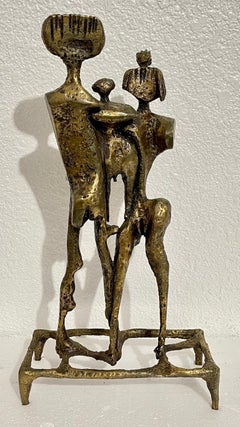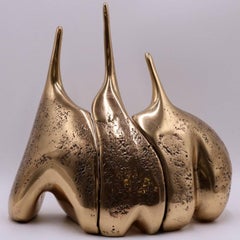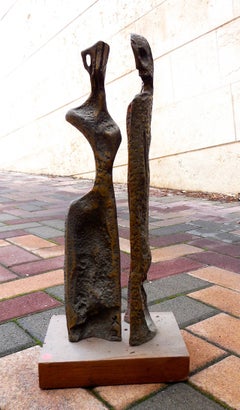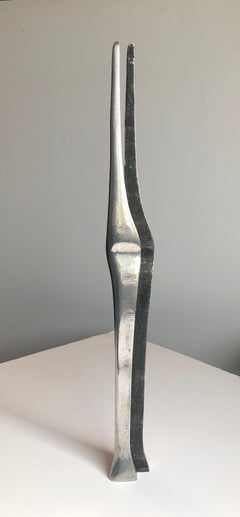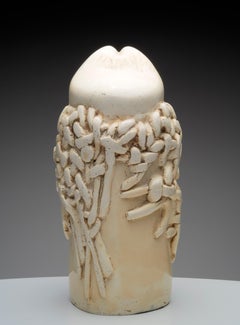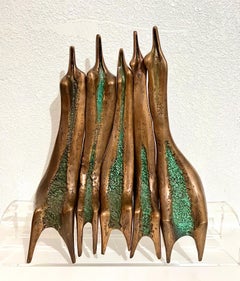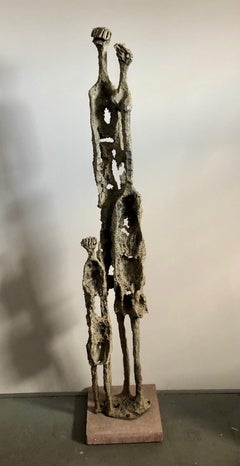Aharon Bezalel Art
to
3
1
Overall Width
to
Overall Height
to
4
1
2
3
1
4
3
9
7,820
5,167
2,504
1,501
4
Artist: Aharon Bezalel
Large Aharon Bezalel Israeli Modernist Bronze Brutalist Puzzle Sculpture Figures
By Aharon Bezalel
Located in Surfside, FL
Aharon Bezalel (Afghani-Israeli, 1925-2012)
Family Grouping
Hand signed in with initials in English
Figures fit together like puzzle pieces in solid cast bronze with original patina.
Aharon Bezalel (born Afghanistan 1926) Born in Herat, Afghanistan in 1926 and immigrated to Israel at an early age. His father, Reuven Bezalel, was a rabbi and kabbalist. As a youth Aharon studied gold and silver casting as well as applied arts and worked in these fields as a silversmith and judaica craftsman, and was a student of the sculptor Zev Ben-Zvi at the Bezalel Academy for Art & Design where he also studied with Isidor Ascheim and Mordecai Ardon. There he absorbed the basic concepts of classic and modernist art and interpreted, according to them, ideas based on ancient Hebrew sources. He also studied miniature carving with the artists Martin and Helga Rost applying himself at their workshop. Aharon Bezalel worked and resided in Jerusalem, he taught art for many years. His sculptures - works of wood, bronze, aluminum, Plexiglas - were shown at his studio in Ein Kerem. “I saw myself as part of this region. I wanted to find the contact between my art and my surroundings. Those were the first years of Jean Piro’s excavations at the Beer-Sheba mound. They found there, for example, the Canaanite figurines that I especially liked and that were an element that connected me with the past and with this place.” “…a seed and sperm or male and female. These continue life. The singular, the individual alone, cannot exist; I learned this from my father who dabbled with the Kabbalah.”
(Aharon Bezalel, excerpt from an interview with David Gerstein)
“The singular in Aharon Bezalel’s work is always potentially a couple if not a threesome, the one is also the many: when the individual is revealed within the group he will always seek a huddling, a clinging together.
The principle of modular construction is required by this perception of unity and multiplicity, as modular construction in his work is an act of conception or defense. His work bears a similarity to Berrocal as well as affinities to Henry Moore, Lynne Chadwick and Kenneth Armitage. Two poles of unity, potentially alone, exist in A. Bezalel’s world: From a formal, sculptural sense these are the sphere and pillar, metaphorically these are the female in the final stages of pregnancy and the solitary male individual. Sphere-seed-woman; Pillar-strand-man. The disproportional, small heads in A. Bezalel figures leave humankind in it’s primal physical capacity. The woman as a pregnancy or hips, the man as an aggressive or defensive force, the elongated chest serves as a phallus and weapon simultaneously.
(Gideon Ofrat)
EIN HAROD About the Museum's Holdings: Israeli art is represented by the works of Reuven Rubin, Zaritzky, Nahum Gutman...
Category
Mid-20th Century Expressionist Aharon Bezalel Art
Materials
Bronze
Rare Aharon Bezalel Israeli Gilt Modernist Bronze Sculpture Suite
By Aharon Bezalel
Located in Surfside, FL
The width dimensions are variable. the tallest height is 11.5 inches. Family group. A suite of three bronze sculptures.
Aharon Bezalel (born Afghanistan 1926) Born in Afghanistan in 1926 and immigrated to Israel at an early age. As a youth was engaged as a silversmith and craftsman, and was a student of the sculptor Zev Ben-Zvi from whom he absorbed the basic concepts of classic and modernist art and interpreted, according to them, ideas based on ancient Hebrew sources.
Aharon Bezalel works and resides in Jerusalem, he taught art for many years.
“I saw myself as part of this region. I wanted to find the contact between my art and my surroundings. Those were the first years of Jean Piro’s excavations at the Beer-Sheba mound. They found there, for example, the Canaanite figurines that I especially liked and that were an element that connected me with the past and with this place.” “…a seed and sperm or male and female. These continue life. The singular, the individual alone, cannot exist; I learned this from my father who dabbled with the Kabbalah.”
(Aharon Bezalel, excerpt from an interview with David Gerstein)
“The singular in Aharon Bezalel’s work is always potentially a couple if not a threesome[…] the one is also the many: when the individual is revealed within the group he will always seek a huddling, a clinging together.
The principle of modular construction is required by this perception of unity and multiplicity, as modular construction in his work is an act of conception or defense.
Two poles of unity, potentially alone, exist in A. Bezalel’s world: From a formal, sculptural sense these are the sphere and pillar, metaphorically these are the female in the final stages of pregnancy and the solitary male individual. Sphere-seed-woman; Pillar-strand-man. The disproportional, small heads in A. Bezalel’s figures leave humankind in it’s primal physical capacity. The woman as a pregnancy or hips, the man as an aggressive or defensive force, the elongated chest serves as a phallus and weapon simultaneously.
(Gideon Ofrat)
EIN HAROD About the Museum's Holdings: Israeli art is represented by the works of Reuven Rubin, Zaritzky, Nahum Gutman, Mordechai Ardon, Aharon Kahana, Arie Lubin, Yehiel Shemi, Yosl Bergner and others.
The graphic arts collection contains drawings and graphic works by Pissaro, Modigliani, Pascin, Chagall (almost all of his graphic work), and numerous other artists. The sculpture collection includes works by Jewish sculptors from all over the world including leading Israeli sculptors; Ben Zvi, Lishansky, David Palombo, Yehiel Shemi, Aharon Bezalel and Igael Tumarkin.
Many Jewish sculptors from all parts of the world, beginning with Antokolski, are represented in the collection. In the sculpture courtyard there are works by Chana Orloff, Jacob Epstein (the works he bequeathed to the Museum), Glicenstein, Loutchansky, Constant and Indenbaum from Western Europe; Glid from Yugoslavia; Zorach, Gross and Harkavy from the United States; and most of the outstanding sculptors of Israel : Ben-Zvi, Lishansky, Ziffer, Lehmann, Feigin, Sternschuss, Palombo ( who executed the iron gate...
Category
1970s Expressionist Aharon Bezalel Art
Materials
Bronze
Israeli Abstract Figures Art Brut Polychromed Bronze Sculpture Aharon Bezalel
By Aharon Bezalel
Located in Surfside, FL
Aharon Bezalel (born Afghanistan 1926) Born in Afghanistan in 1926 and immigrated to Israel at an early age. As a youth was engaged as a silversmith and craftsman, and was a student of the sculptor Zev Ben-Zvi from whom he absorbed the basic concepts of classic and modernist art and interpreted, according to them, ideas based on ancient Hebrew sources.
Aharon Bezalel works and resides in Jerusalem, he taught art for many years.
“I saw myself as part of this region. I wanted to find the contact between my art and my surroundings. Those were the first years of Jean Piro’s excavations at the Beer-Sheba mound. They found there, for example, the Canaanite figurines that I especially liked and that were an element that connected me with the past and with this place.” “…a seed and sperm or male and female. These continue life. The singular, the individual alone, cannot exist; I learned this from my father who dabbled with the Kabbalah.”
(Aharon Bezalel, excerpt from an interview with David Gerstein)
“The singular in Aharon Bezalel’s work is always potentially a couple if not a threesome[…] the one is also the many: when the individual is revealed within the group he will always seek a huddling, a clinging together.
The principle of modular construction is required by this perception of unity and multiplicity, as modular construction in his work is an act of conception or defense.
Two poles of unity, potentially alone, exist in A. Bezalel’s world: From a formal, sculptural sense these are the sphere and pillar, metaphorically these are the female in the final stages of pregnancy and the solitary male individual. Sphere-seed-woman; Pillar-strand-man. The disproportional, small heads in A. Bezalel’s figures leave humankind in it’s primal physical capacity. The woman as a pregnancy or hips, the man as an aggressive or defensive force, the elongated chest serves as a phallus and weapon simultaneously.
(Gideon Ofrat)
EIN HAROD About the Museum's Holdings: Israeli art is represented by the works of Reuven Rubin, Zaritzky, Nahum Gutman...
Category
1960s Expressionist Aharon Bezalel Art
Materials
Bronze
Aharon Bezalel Israeli Modernist Sculpture 2 Parts Minimalist Aluminum or Steel
By Aharon Bezalel
Located in Surfside, FL
A suite of 2 sculptures. Lovers, man and woman nestled together. sleek minimalist mod sculpture.
polished finish on one side. not sure if theese are stell or aluminium. they are cast and signed in Hebrew with initials and numbered 9/9. It is 2 parts that nest together.
Aharon Bezalel (born Afghanistan 1926) Born in Afghanistan in 1926 and immigrated to Israel at an early age. As a youth was engaged as a silversmith and craftsman, and was a student of the sculptor Zev Ben-Zvi from whom he absorbed the basic concepts of classic and modernist art and interpreted, according to them, ideas based on ancient Hebrew sources.
Aharon Bezalel works and resides in Jerusalem, he taught art for many years.
“I saw myself as part of this region. I wanted to find the contact between my art and my surroundings. Those were the first years of Jean Piro’s excavations at the Beer-Sheba mound. They found there, for example, the Canaanite figurines that I especially liked and that were an element that connected me with the past and with this place.” “…a seed and sperm or male and female. These continue life. The singular, the individual alone, cannot exist; I learned this from my father who dabbled with the Kabbalah.”
(Aharon Bezalel, excerpt from an interview with David Gerstein)
“The singular in Aharon Bezalel’s work is always potentially a couple if not a threesome, the one is also the many: when the individual is revealed within the group he will always seek a huddling, a clinging together.
The principle of modular construction is required by this perception of unity and multiplicity, as modular construction in his work is an act of conception or defense.
Two poles of unity, potentially alone, exist in Aaron Bezalel’s world: From a formal, sculptural sense these are the sphere and pillar, metaphorically these are the female in the final stages of pregnancy and the solitary male individual. Sphere-seed-woman; Pillar-strand-man. The disproportional, small heads in Aharon Bezalel’s figures leave humankind in it’s primal physical capacity. The woman as a pregnancy or hips, the man as an aggressive or defensive force, the elongated chest serves as a phallus and weapon simultaneously.
(Gideon Ofrat)
EIN HAROD About the Museum's Holdings: Israeli art is represented by the works of Reuven Rubin, Zaritzky, Nahum Gutman, Mordechai Ardon, Aharon Kahana, Arie Lubin, Yehiel Shemi...
Category
1970s Minimalist Aharon Bezalel Art
Materials
Metal
Related Items
Raul Valdivieso Latin American Erotic Ceramic Sculpture, 1960s
By Raúl Valdivieso
Located in Washington, DC
One of a kind ceramic sculpture by Latin American sculptor Raúl Valdivieso (Chilean, 1931-1993). Valdivieso is known for his reinterpretation of classic organic forms and human figures. Sculpture retains the original wood and black laminate base with metal cage. Ceramic is in good original condition. Laminate is in poor condition with a few chips.
Raúl Valdiveso was born September 9, 1931 in Santiago, Chile. In 1952 he began his studies at the School of Fine Arts at the University of Chile. There he took to sculpture and studied under professors like Marta Colvin...
Category
1960s Modern Aharon Bezalel Art
Materials
Metal
H 14 in W 14 in D 14 in
1980 Italy Late 20th Century Bronze Multiple Bust Him by Roberto Nanut
Located in Brescia, IT
This engaging bronze sculpture on black wooden base, well represents a human bust, but for its expressive force, the bust turns into an abstract shape of it.
The artist who created t...
Category
Late 20th Century Post-Modern Aharon Bezalel Art
Materials
Bronze
H 6.11 in W 2.76 in D 2.17 in
The Pleiades-Celaeno 4/8 - emotive, nude, female, figurative, bronze statuette
By Richard Tosczak
Located in Bloomfield, ON
Canadian artist Richard Tosczak is known for his beautiful figurative sculptures. This bronze statuette of a nude female leaning as if against a wall, hands behind her back was first...
Category
2010s Contemporary Aharon Bezalel Art
Materials
Bronze
Hajime Sorayama Sexy Robot Floating Black Contemporary Art LED Light
Located in Draper, UT
Sexy Robot Floating (Black), 2020
PVC, plated resin, alloy, and LED light
22 × 14 × 14 in
55.9 × 35.6 × 35.6 cm
Edition of only 250.
Category
2010s Pop Art Aharon Bezalel Art
Materials
Metal
H 22 in W 14 in D 14 in
Harmony, 20th century bronze & green marble base, nude man and woman with lyre
By Max Kalish
Located in Beachwood, OH
Max Kalish (American, 1891-1945)
Harmony, c. 1930
Bronze with green marble base
Incised signature on right upper side of base
14 x 9 x 5 inches, excluding base
17 x 10 x 8 inches, including base
Born in Poland March 1, 1891, figurative sculptor Max Kalish came to the United States in 1894, his family settling in Ohio. A talented youth, Kalish enrolled at the Cleveland Institute of Art as a fifteen-year-old, receiving a first-place award for modeling the figure during studies with Herman Matzen. Kalish went to New York City following graduation, studying with Isidore Konti...
Category
1930s American Modern Aharon Bezalel Art
Materials
Marble, Bronze
Latin American Raúl Valdivieso Bronze Organic Abstract Sculpture
By Raúl Valdivieso
Located in Washington, DC
Striking bronze organic sculpture by Latin American sculptor Raúl Valdivieso (Chilean, 1931-1993). Valdivieso is known for his reinterpretation of the ...
Category
1960s Modern Aharon Bezalel Art
Materials
Bronze
H 15 in W 12 in D 8 in
Ruth Bloch, Kiss, romantic bronze sculpture, minimalist sculpture
By Ruth Bloch
Located in Tel Aviv, IL
Ruth Bloch, Bronze sculpture, Kiss, 2 figures, classic theme , romantic sculpture, minimalist sculpture
Category
Early 2000s Minimalist Aharon Bezalel Art
Materials
Bronze
Cubist Nude Bronze Sculpture
Located in Lake Worth Beach, FL
Cubist Nude
Patinated Bronze Sculpture.
Dominique Polles' bronze sculptures of female nude edition 2/4 patinated bronze signed and dated 1999. Born in Paris in 1945, young Pollès of...
Category
1990s Cubist Aharon Bezalel Art
Materials
Bronze
1980 Italy Post-Modern Rodica Tanasescu Bronze Abstract Sculpture Title Incontro
Located in Brescia, IT
This artwork was created by the Italian artist Rodica Tanasescu. The title " Incontro" The meeting
Rodica Tanasescu was born in Rumania and now lives in and works in Mestre, (Venezia...
Category
Late 20th Century Post-Modern Aharon Bezalel Art
Materials
Bronze
H 7.88 in W 3.15 in D 0.99 in
Aquila- 21st Century Contemporary Bronze Realistic Sculpture of a Nude Boy
By Wim van der Kant
Located in Nuenen, Noord Brabant
Aquila
Bronze Sculpture on pedestal of marble
Hight bronze 57 cm with pedestal of marble (included) 68 cm
Wim van der Kant's sculptures are in bronze...
Category
2010s Contemporary Aharon Bezalel Art
Materials
Marble, Bronze
H 22.45 in W 8.27 in D 7.09 in
Vintage Figurative Abstract Tribal Creature Head Sculpture
By Nathaniel Sirles
Located in Soquel, CA
Evocative figurative abstract sculpture of the head of a tribal creature by Nathaniel Sirles (American, b. 1954). Signed and dated "N. Sirles 1970" on the bottom. Sirles completed th...
Category
1970s Expressionist Aharon Bezalel Art
Materials
Stone
H 7 in W 4 in D 6.5 in
1980 Italy Late 20th Century Bronze Multiple Bust Her
Located in Brescia, IT
This engaging bronze sculpture on black wooden base, well represents a human bust, but for its expressive force, the bust turns into an abstract shape of it.
The artist who created t...
Category
Late 20th Century Post-Modern Aharon Bezalel Art
Materials
Bronze
H 6.11 in W 2.76 in D 2.17 in
Previously Available Items
Large Aharon Bezalel Israeli Modernist Bronze Brutalist Puzzle Sculpture Figures
By Aharon Bezalel
Located in Surfside, FL
Aharon Bezalel (Afghani-Israeli, 1925-2012)
1984
Edition 4/9
Family Grouping
Hand signed in Hebrew with initials and in English
Movable figures that fit together like puzzle pieces in solid cast bronze with original patina on a lucite bench base.
23 X 19 X 6 base is 24 X 6 X 6
Aharon Bezalel (born Afghanistan 1926) Born in Herat, Afghanistan in 1926 and immigrated to Israel at an early age. His father, Reuven Bezalel, was a rabbi and kabbalist. As a youth Aharon studied gold and silver casting as well as applied arts and worked in these fields as a silversmith and judaica craftsman, and was a student of the sculptor Zev Ben-Zvi at the Bezalel Academy for Art & Design where he also studied with Isidor Ascheim and Mordecai Ardon. There he absorbed the basic concepts of classic and modernist art and interpreted, according to them, ideas based on ancient Hebrew sources. He also studied miniature carving with the artists Martin and Helga Rost applying himself at their workshop. Aharon Bezalel worked and resided in Jerusalem, he taught art for many years. His sculptures - works of wood, bronze, aluminum, Plexiglas - were shown at his studio in Ein Kerem. “I saw myself as part of this region. I wanted to find the contact between my art and my surroundings. Those were the first years of Jean Piro’s excavations at the Beer-Sheba mound. They found there, for example, the Canaanite figurines that I especially liked and that were an element that connected me with the past and with this place.” “…a seed and sperm or male and female. These continue life. The singular, the individual alone, cannot exist; I learned this from my father who dabbled with the Kabbalah.”
(Aharon Bezalel, excerpt from an interview with David Gerstein)
“The singular in Aharon Bezalel’s work is always potentially a couple if not a threesome, the one is also the many: when the individual is revealed within the group he will always seek a huddling, a clinging together.
The principle of modular construction is required by this perception of unity and multiplicity, as modular construction in his work is an act of conception or defense. His work bears a similarity to Berrocal as well as affinities to Henry Moore, Lynne Chadwick and Kenneth Armitage. Two poles of unity, potentially alone, exist in A. Bezalel’s world: From a formal, sculptural sense these are the sphere and pillar, metaphorically these are the female in the final stages of pregnancy and the solitary male individual. Sphere-seed-woman; Pillar-strand-man. The disproportional, small heads in A. Bezalel figures leave humankind in it’s primal physical capacity. The woman as a pregnancy or hips, the man as an aggressive or defensive force, the elongated chest serves as a phallus and weapon simultaneously.
(Gideon Ofrat)
EIN HAROD About the Museum's Holdings: Israeli art is represented by the works of Reuven Rubin, Zaritzky, Nahum Gutman...
Category
Mid-20th Century Expressionist Aharon Bezalel Art
Materials
Bronze
Rare Large Aharon Bezalel Israeli Modernist Unique Bronze Brutalist Sculpture
By Aharon Bezalel
Located in Surfside, FL
Monumental, Unique Aharon Bezalel (Israel 1925-2012) Silvered Metal Sculpture. (I assume it is bronze but am not positive of the composition) Measurements - 63.5 inches high x 12 wide x 12 deep. It is signed at the metal base.
Depicting a family group.
Aharon Bezalel (born Afghanistan 1926) Born in Herat, Afghanistan in 1926 and immigrated to Israel at an early age. His father, Reuven Bezalel, was a rabbi and kabbalist. As a youth Aharon studied gold and silver casting as well as applied arts and worked in these fields as a silversmith and judaica craftsman, and was a student of the sculptor Zev Ben-Zvi at the Bezalel Academy for Art & Design where he also studied with Isidor Ascheim and Mordechai Ardon. There he absorbed the basic concepts of classic and modernist art and interpreted, according to them, ideas based on ancient Hebrew sources. He also studied miniature carving with the artists Martin and Helga Rost applying himself at their workshop. Aharon Bezalel worked and resided in Jerusalem, he taught art for many years. His sculptures - works of wood, bronze, aluminum, Plexiglas - were shown at his studio in Ein Kerem. “I saw myself as part of this region. I wanted to find the contact between my art and my surroundings. Those were the first years of Jean Piro’s excavations at the Beer-Sheba mound. They found there, for example, the Canaanite figurines that I especially liked and that were an element that connected me with the past and with this place.” “…a seed and sperm or male and female. These continue life. The singular, the individual alone, cannot exist; I learned this from my father who dabbled with the Kabbalah.”
(Aharon Bezalel, excerpt from an interview with David Gerstein)
“The singular in Aharon Bezalel’s work is always potentially a couple if not a threesome, the one is also the many: when the individual is revealed within the group he will always seek a huddling, a clinging together.
The principle of modular construction is required by this perception of unity and multiplicity, as modular construction in his work is an act of conception or defense. Two poles of unity, potentially alone, exist in A. Bezalel’s world: From a formal, sculptural sense these are the sphere and pillar, metaphorically these are the female in the final stages of pregnancy and the solitary male individual. Sphere-seed-woman; Pillar-strand-man. The disproportional, small heads in A. Bezalel’s figures leave humankind in it’s primal physical capacity. The woman as a pregnancy or hips, the man as an aggressive or defensive force, the elongated chest serves as a phallus and weapon simultaneously.
(Gideon Ofrat)
EIN HAROD About the Museum's Holdings: Israeli art is represented by the works of Reuven Rubin, Zaritzky, Nahum Gutman, Mordecai Ardon, Aharon Kahana, Arie Lubin, Yehiel Shemi, Yosl Bergner and others.
The graphic arts collection contains drawings and graphic works by Pissaro, Modigliani, Jules Pascin, Marc Chagall (almost all of his graphic work), and numerous other artists. The sculpture collection includes works by Jewish sculptors from all over the world including leading Israeli sculptors; Ben Zvi, Lishansky, David Palombo, Yehiel Shemi, Aharon Bezalel and Igael Tumarkin. Many Jewish sculptors from all parts of the world, beginning with Mark Antokolsky, are represented in the collection. In the sculpture courtyard there are works by Chana Orloff, Jacob Epstein (the works he bequeathed to the Museum), Enrico Glicenstein, Loutchansky, Joseph Constant...
Category
Mid-20th Century Expressionist Aharon Bezalel Art
Materials
Stone, Bronze, Metal
Rare Aharon Bezalel Israeli Modernist Mother and Child Bronze Sculpture Suite
By Aharon Bezalel
Located in Surfside, FL
Family group. Mother and Baby A suite of two bronze sculptures. It is hand signed in English and initialed in Hebrew and dated. There is no edition number, it might be unique.
size includes base.
Aharon Bezalel (born Afghanistan 1926) Born in Afghanistan in 1926 and immigrated to Israel at an early age. As a youth was engaged as a silversmith and craftsman, and was a student of the sculptor Zev Ben-Zvi from whom he absorbed the basic concepts of classic and modernist art and interpreted, according to them, ideas based on ancient Hebrew sources.
Aharon Bezalel works and resides in Jerusalem, he taught art for many years.
“I saw myself as part of this region. I wanted to find the contact between my art and my surroundings. Those were the first years of Jean Piro’s excavations at the Beer-Sheba mound. They found there, for example, the Canaanite figurines that I especially liked and that were an element that connected me with the past and with this place.” “…a seed and sperm or male and female. These continue life. The singular, the individual alone, cannot exist; I learned this from my father who dabbled with the Kabbalah.”
(Aharon Bezalel, excerpt from an interview with David Gerstein)
“The singular in Aharon Bezalel’s work is always potentially a couple if not a threesome[…] the one is also the many: when the individual is revealed within the group he will always seek a huddling, a clinging together.
The principle of modular construction is required by this perception of unity and multiplicity, as modular construction in his work is an act of conception or defense.
Two poles of unity, potentially alone, exist in A. Bezalel’s world: From a formal, sculptural sense these are the sphere and pillar, metaphorically these are the female in the final stages of pregnancy and the solitary male individual. Sphere-seed-woman; Pillar-strand-man. The disproportional, small heads in A. Bezalel’s figures leave humankind in it’s primal physical capacity. The woman as a pregnancy or hips, the man as an aggressive or defensive force, the elongated chest serves as a phallus and weapon simultaneously.
(Gideon Ofrat)
EIN HAROD About the Museum's Holdings: Israeli art is represented by the works of Reuven Rubin, Zaritzky, Nahum Gutman, Mordechai Ardon, Aharon Kahana, Arie Lubin, Yehiel Shemi...
Category
1980s Expressionist Aharon Bezalel Art
Materials
Bronze
H 9.25 in W 5.5 in D 5.5 in
Aharon Bezalel Israeli Modernist Sculpture 2 Parts Minimalist Aluminum or Steel
By Aharon Bezalel
Located in Surfside, FL
A suite of 2 sculptures. Lovers, man and woman nestled together. sleek minimalist mod sculpture.
polished finish on one side. not sure if theese are stel...
Category
1970s Minimalist Aharon Bezalel Art
Materials
Metal
H 25.5 in W 2.5 in D 2 in
Rare AP Aharon Bezalel Israeli Modernist Mother and Child Bronze Sculpture Suite
By Aharon Bezalel
Located in Surfside, FL
Family group. Mother and Baby A suite of two bronze sculptures.
Aharon Bezalel (born Afghanistan 1926) Born in Afghanistan in 1926 and immigrated to Israel at an early age. As a you...
Category
1980s Expressionist Aharon Bezalel Art
Materials
Bronze
Rare Aharon Bezalel Israeli Gilt Modernist Bronze Sculpture Suite
By Aharon Bezalel
Located in Surfside, FL
The width dimensions are variable. the tallest height is 11.5 inches. Family group. A suite of three bronze sculptures.
Aharon Bezalel (born Afghanistan 1926) Born in Afghanistan in...
Category
1970s Expressionist Aharon Bezalel Art
Materials
Bronze
Two Figures (Art Brut Bronze Sculpture)
By Aharon Bezalel
Located in Surfside, FL
Aharon Bezalel (born Afghanistan 1926) Born in Afghanistan in 1926 and immigrated to Israel at an early age. As a youth was engaged as a silversmith and craftsman, and was a student of the sculptor Zev Ben-Zvi from whom he absorbed the basic concepts of classic and modernist art and interpreted, according to them, ideas based on ancient Hebrew sources.
Aharon Bezalel works and resides in Jerusalem, he taught art for many years.
“I saw myself as part of this region. I wanted to find the contact between my art and my surroundings. Those were the first years of Jean Piro’s excavations at the Beer-Sheba mound. They found there, for example, the Canaanite figurines that I especially liked and that were an element that connected me with the past and with this place.” “…a seed and sperm or male and female. These continue life. The singular, the individual alone, cannot exist; I learned this from my father who dabbled with the Kabbalah.”
(Aharon Bezalel, excerpt from an interview with David Gerstein)
“The singular in Aharon Bezalel’s work is always potentially a couple if not a threesome[…] the one is also the many: when the individual is revealed within the group he will always seek a huddling, a clinging together.
The principle of modular construction is required by this perception of unity and multiplicity, as modular construction in his work is an act of conception or defense.
Two poles of unity, potentially alone, exist in A. Bezalel’s world: From a formal, sculptural sense these are the sphere and pillar, metaphorically these are the female in the final stages of pregnancy and the solitary male individual. Sphere-seed-woman; Pillar-strand-man. The disproportional, small heads in A. Bezalel’s figures leave humankind in it’s primal physical capacity. The woman as a pregnancy or hips, the man as an aggressive or defensive force, the elongated chest serves as a phallus and weapon simultaneously.
(Gideon Ofrat)
EIN HAROD About the Museum's Holdings: Israeli art is represented by the works of Reuven Rubin, Zaritzky, Nahum Gutman, Mordechai Ardon, Aharon Kahana, Arie Lubin, Yehiel Shemi...
Category
1960s Expressionist Aharon Bezalel Art
Materials
Bronze
Aharon Bezalel art for sale on 1stDibs.
Find a wide variety of authentic Aharon Bezalel art available for sale on 1stDibs. You can also browse by medium to find art by Aharon Bezalel in metal, bronze, lucite and more. Much of the original work by this artist or collective was created during the 20th century and is mostly associated with the Expressionist style. Not every interior allows for large Aharon Bezalel art, so small editions measuring 3 inches across are available. Customers who are interested in this artist might also find the work of Chris Riccardo, Branko Bahunek, and Walter Furlan. Aharon Bezalel art prices can differ depending upon medium, time period and other attributes. On 1stDibs, the price for these items starts at $1,800 and tops out at $9,500, while the average work can sell for $3,800.
